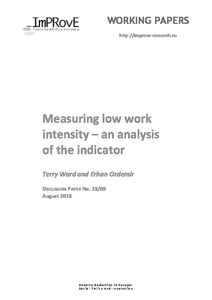Measuring low work intensity – an analysis of the indicator
"This paper is a critical assessment of the indicator which has been developed to measure the relative number of people living in households with low, or very low, work intensity which is part of the Europe 2020 target set to reduce poverty and social exclusion in the European Union. It conside...
| Main Authors: | , , |
|---|---|
| Institution: | ETUI-European Trade Union Institute |
| Format: | TEXT |
| Language: | English |
| Published: |
Antwerp
2013
ImPRovE |
| Subjects: | |
| Online Access: | https://www.labourline.org/KENTIKA-19124108124919423809-Measuring-low-work-intensity--.htm |
| _version_ | 1771659902675058690 |
|---|---|
| author | ImPRovE, Antwerp Ward, Terry Ozdemir, Erhan |
| author_facet | ImPRovE, Antwerp Ward, Terry Ozdemir, Erhan |
| collection | Library items |
| description | "This paper is a critical assessment of the indicator which has been developed to measure the relative number of people living in households with low, or very low, work intensity which is part of the Europe 2020 target set to reduce poverty and social exclusion in the European Union. It considers the way the indicator is defined and calculated, in particular, the age group taken to be of working-age, the treatment of students, the threshold defined to denote low work intensity and the extent of missing cases. It also examines how far the source of data used – the EU-SILC – correctly distinguishes those of working age who were not employed, or at least very little, over the year to which the indicator applies. It assesses, in addition, whether it is possible to use the Labour Force Survey (LFS) to estimate low household work intensity in advance of the EU-SILC data becoming available, given that that there is a lengthy delay between the year to which the EU-SILC relates and the publication of the data. It considers as well whether it is possible to estimate a measure of persistently low work intensity from the EU-SILC longitudinal data to complement the indicator and add a further level of detail relevant for policy. Finally, it assesses the reliability of the indicator from a statistical perspective by estimating the confidence intervals surrounding the point-estimates both for low work intensity in a particular year and for persistently low work intensity over a 4-year period." |
| format | TEXT |
| geographic | EU countries |
| id | 19124108124919423809_dae2418f771f4c17a55f140d24e1bd02 |
| institution | ETUI-European Trade Union Institute |
| is_hierarchy_id | 19124108124919423809_dae2418f771f4c17a55f140d24e1bd02 |
| is_hierarchy_title | Measuring low work intensity – an analysis of the indicator |
| language | English |
| physical | 34 p. Digital |
| publishDate | 2013 |
| publisher | Antwerp ImPRovE |
| spellingShingle | ImPRovE, Antwerp Ward, Terry Ozdemir, Erhan economic indicator measurement work load Europe 2020 Measuring low work intensity – an analysis of the indicator |
| thumbnail | https://www.labourline.org/Image_prev.jpg?Archive=100121392830 |
| title | Measuring low work intensity – an analysis of the indicator |
| topic | economic indicator measurement work load Europe 2020 |
| url | https://www.labourline.org/KENTIKA-19124108124919423809-Measuring-low-work-intensity--.htm |

